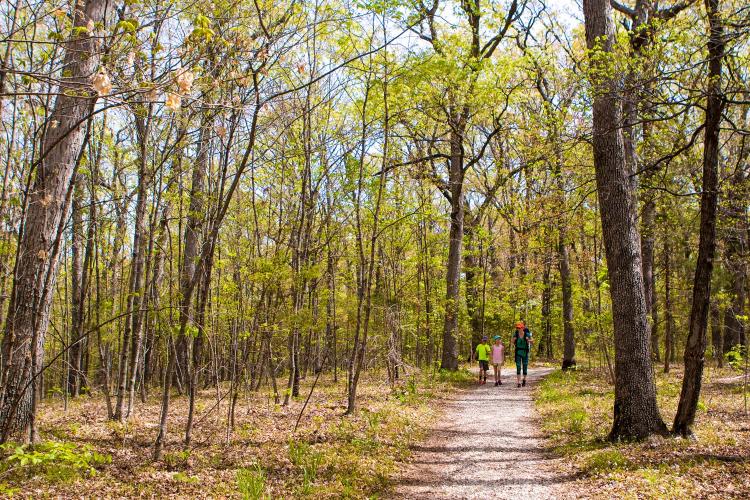The summer months are often a time to gather family and friends, hit the road, and enjoy a relaxing vacation. But what if that vacation turned into a staycation — a close-to home adventure where you could explore nature among woodlands, hills, mountains, or marshes? Or browse indoor, kid-friendly nature exhibits in the comfort of air-conditioning? MDC offers fun staycation destinations at nature centers and conservation areas throughout Missouri.
Whether you visit for an hour or a day, MDC has a place within easy driving distance where nature can be seen, touched, heard, and felt. MDC’s regional media specialists have put together their best bets for a staycation destination in each of the eight regions of the state.
Northwest Region: Poosey Conservation Area
Poosey Conservation Area (CA) offers fishing and hiking amid a variety of habitats. Included within the area's 5,863-acres are two lakes, nine ponds, trails, forests, restored grasslands, and old crop fields that support a wide variety of fish and wildlife. Nine ponds on the area also offer fishing for bass, catfish, and bluegill. Indian Creek Lake and Pike’s Lake offer good fishing, and both lakes have boat ramps. Indian Creek Lake also has a dock and a fishing-cleaning station. Primitive campsites, picnic areas, and a pavilion are available.
Poosey CA has designated trails open to both hiking and bicycling. The Green Hills Trail is designed for mountain biking. Some trails are also open for equestrian use.
“Poosey is also a good place for birding,” Graham said. “Visitors can watch for wildlife, such as deer and turkeys, while hiking or driving along area roads. Wildflowers and ferns common to hardwood forests can be found on the steep, wooded hillsides, especially in spring.”
Kansas City Region: Burr Oak Woods Nature Center and Conservation Area
Kansas City Regional Media Specialist Bill Graham is a big fan of Burr Oak Woods Nature Center and Conservation Area in Blue Springs.
“You can step into a shady forest, hike among the wildflowers and grasses in a restored prairie meadow, or see fish from a turtle’s viewpoint,” Graham said. Burr Oak Woods has six hiking trails. Two loops are paved and easily accessible; the other four are rustic, but all are scenic. Hikers can spend a day or more traversing all the trails. Be alert — these trails are a good place to spot wildlife, including deer and turkeys.
After a hike, stop in the nature center. Visitors will find native fish swimming in a 3,000-gallon aquarium. Interpretive displays explain conservation and nature. Several exhibits are child friendly, mixing education and play.
Ozark Region: Caney Mountain Conservation Area
Candice Davis, media specialist for the southeast and Ozark regions, is most impressed with the grand vistas at Caney Mountain Conservation Area.
The nearly 8,000-acre area boasts a rough landscape of hills left by an old elevated plateau, and carved out by several streams. Visitors can enjoy views of large peaks, including Bear Cave Mountain, High Rock Mountain, Morrison Knob, Long, Bald, and Tater Cave Mountain.
Those who step out of their vehicles to observe the smaller scale beauty of the area will take in the ruggedness of its glades, savannas, and forest openings that are broken up by several creek bottoms. The combination of these various habitats makes Caney Mountain a safe haven for several of Missouri’s rare and endangered species, as well as more common wildlife. This variety in habitats is also the reason Caney Mountain played an important role in wild turkey and white-tailed deer restoration efforts in the 1940s.
“Plan to spend the day exploring,” Davis said. “Bring binoculars and bird-watch, hike, or mountain bike on the area’s gravel roads and trails.”
There are three trail options — the multi-use trail, Long Bald Nature Trail, and Spout Spring Trail — ranging in difficulty from easy to moderate and from 6.5 miles to a half-mile loop. Watch for white-tailed deer, squirrels, wild turkeys, rabbits, and a variety of bird species. Caney Mountain is in the heart of bear country, so be bear aware and keep food and any other tempting items locked away and out of reach of bears.
Southeast Region: Otter Slough Conservation Area
When early explorers reached what is now southeast Missouri, they were presented with crossing a seemingly endless expanse of swampland. It was miles on miles of bottomland timber amongst interconnecting sloughs. To get an idea of what that was like, spend a day at Otter Slough Conservation Area in Stoddard County.
Although this 4,866-acre area is managed primarily for migratory and wintering waterfowl, many wading birds, shorebirds, eagles, and wetland mammals make Otter Slough their home. Otter Lake, the 250-acre cypress and tupelo swamp, is a beautiful destination to canoe or kayak. Before visiting, visit short.mdc.mo.gov/ZST to ensure there’s plenty of water in the lake, as annual drawdowns, usually occurring in July, are used for waterfowl and timber management.
Visitors can fish in Cypress Lake and see 30-inch diameter willow oaks in Bradyville Natural Area. An abundance of waterfowl and wildlife are often seen even from the area’s gravel roads. The nature trail provides excellent hiking and wildlife viewing that includes boardwalks through cypress-tupelo swamps. Hiking takes about a half-hour.
“Early summer and fall are best for viewing native plant life, but songbird and waterfowl migrations peak in spring and fall,” Davis said. “Otter Slough attracts rare migratory birds because of the unique habitat. Black-bellied whistling ducks visit most summers and the king rail has been spotted with one documented brood. Occasionally, birders have viewed roseate spoonbills and wood storks.”
Southwest Region: Springfield Conservation Nature Center
“If you’re looking for a day-trip or an afternoon hike that’s rich in nature-viewing opportunities but cheap on the gas tank, look no further than MDC’s Springfield Conservation Nature Center in Springfield,” said Southwest Region Media Specialist Francis Skalicky.
The Springfield Conservation Nature Center is a small piece of the Ozarks nestled within Springfield’s city limits. It’s a good place to connect with nature and to learn the importance of conserving it, too.
Visitors can explore the building’s exhibit area and experience the sights and sounds of Missouri’s natural communities. Relax in the nature center’s indoor viewing area and get an intimate look at birds and other wildlife that visit the pond and feeders.
Moving outside the nature center building, explore the 79-acre area by hiking one of six trails that total nearly 3 miles. “Trail users can see Ozark forest, glade, and prairie habitat and also enjoy the beauty of creeks and frontage on Lake Springfield,” Skalicky said. “Seeing wildlife is a frequent occurrence — more than 170 species inhabit the area.”
St. Louis Region: August A. Busch Shooting Range and Outdoor Education Center
St. Louis Region Media Specialist Dan Zarlenga knows shooting enthusiasts don’t need to travel far to enjoy the benefits of a world-class shooting facility.
The all-new August A. Busch Shooting Range and Outdoor Education Center in St. Charles is now open, replacing the old facility, which was built in the 1970s.
“The new range is completely modern and state of the art,” Zarlenga said. “It features 20 shooting stations for handgun and rifles, with movable target positions out to 100 yards, and an additional 15 stations out to 50 yards.”
Shotgun shooters will enjoy five trap and skeet overlay fields and two shotgun-patterning lanes.
Firearm shooting is not the only option at the new Busch Range. A static archery range with an elevated platform is also offered, as are broadhead practice pits.
The new range incorporates the most current national shooting range design standards and many other improvements for user convenience, safety, and reduced wait times.
Usage fees are very reasonable — just $3 for an hour on the rifle/pistol range, which includes paper targets and basic ear and eye protection. That same amount affords shotgun shooters a round of 25 clay birds on the trap and skeet fields. And archers can shoot for free.
Northeast Region: Union Ridge Conservation Area/Spring Creek Ranch Natural Area
Travel just a half-hour northwest of Kirksville via Highway 6 to Highway D and you’ll find yourself in the heart of Union Ridge Conservation Area.
This 8,262-acre tract of public land offers a mosaic of woodlands, grasslands, old fields, prairie, savanna, and forest. Named for a Civil War-era U.S. Post Office and a ridge on the northern portion of the area, the property was primarily used for grazing cattle until MDC established the area for public use in 1989.
MDC has set aside 1,769-acres in a south-central section of
the area called Spring Creek Ranch Natural Area. Once dominated by fescue, years of careful management have returned this area to a diverse mix of native grasses and wildflowers. “Visitors can hike through forest and woodlands, wander among short, steep hills mantled in native grasses, and enjoy a rare view of native savanna in Missouri,” said Robert Hemmelgarn, media specialist for the northeast and central regions.
The area offers opportunities for primitive camping, lake and pond fishing, deer, turkey, small game, and upland bird hunting, wildlife photography, and bird watching. Audubon Missouri even maintains an interactive list of birds identified on the area at ebird.org/ebird/hotspot/L342576.
Central Region: Painted Rock Conservation Area
Just south of Jefferson City in rural Osage County, MDC’s Painted Rock Conservation Area rests between Highway 133 and the Osage River.
“Hike the 1.6 mile interpretive Osage Scenic Bluff Trail, a loop that features bluff-top boardwalks and viewing decks and reveals evidence of American Indians from as early as 9,000 years ago,” said Hemmelgarn. “One Indian burial cairn along the trail is between 500 and 1,500 years old.”
A group of Jefferson City dignitaries bought the property in 1877 and named it the Painted Rock Country Club. MDC purchased the property in 1981 and now manages the area for fish, forest, and wildlife. Clubhouse Lake remains and features lakeside primitive camping.
Explore native bottomland hardwood forests along the Osage River, discover several small, sensitive glade communities (dry, desert-like areas), and a kaleidoscope of wildflowers.
The area provides public access to hunting and fishing opportunities. Proximity to the Osage River offers access to fishing, supporting sunfish, bass, and catfish, as well as nongame species. It also makes this area a convenient put-in or take-out spot for quiet float trips through Missouri’s northern reaches of the Ozarks. Watch for eagles, forest birds, and other wildlife along the way.
Discover nature in Missouri on your next vacation!
More than 1 million acres of conservation land awaits you. For more information on these or other areas to visit during your next staycation, visit short. mdc.mo.gov/Z4V.






















Also In This Issue


And More...
This Issue's Staff
Associate Editor - Bonnie Chasteen
Staff Writer - Larry Archer
Staff Writer - Heather Feeler
Staff Writer - Kristie Hilgedick
Staff Writer - Joe Jerek
Creative Director - Stephanie Thurber
Art Director - Cliff White
Designer - Les Fortenberry
Designer - Marci Porter
Photographer - Noppadol Paothong
Photographer - David Stonner
Circulation - Laura Scheuler






















